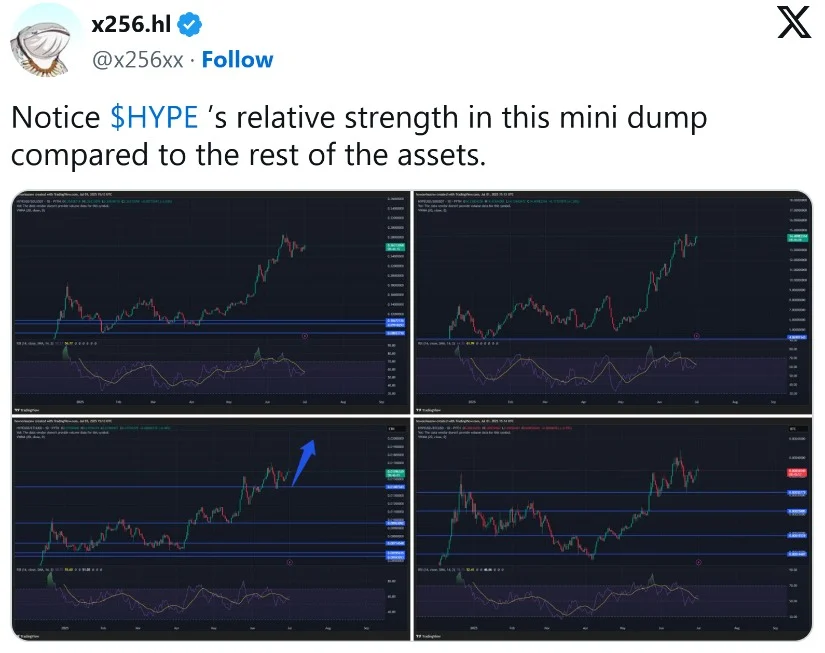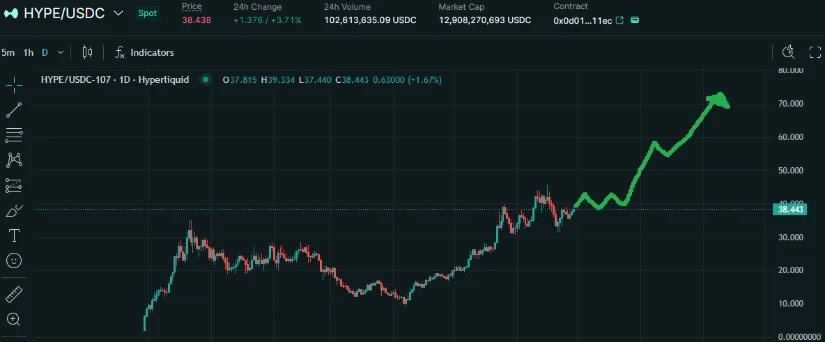Key Insights:
- Hyperliquid is trading at $39.30 after rebounding strongly from the $34 support level earlier this week.
- The token holds above the $38 to $39 zone, which acts as a key short-term support area.
- The recent price action shows a strong structure despite the broader market weakness affecting other altcoins.
Hyperliquid is trading at $39.30, down 3.63% today, yet it maintains strong technical support. The asset recently rebounded from $34 and continues to show resilience despite broader market pressure. With tightening supply and a defined structure, HYPE may soon target higher levels, possibly reaching $45 or even approaching $100.
Hyperliquid Price Structure Remains Intact
Hyperliquid’s price has held firm above short-term support after a sharp rebound earlier this week. The asset received good demand at levels close to the $34 mark and soon regained its positions in the area of $38-$39, which is currently serving as a major support block to short-term structure.
Momentum indicators show that HYPE’s recent move followed a V-shaped reversal, and it now faces initial resistance near $42. The trend has slowed down a bit, as depicted by slightly downwardly ticked volume. Nevertheless, the Relative Strength Index (RSI) is in the middle, which means that there is room to move both up and down any further.
As long as the price stays above the $37.80 to $38.20 change, bulls might try to hit resistance at the $42 mark. With a convincing breakout above this level, the breach may turn the price’s attention to the area of 45 dollars, which coincides with the recent swing highs. On the negative side, a break below this zone can result in re-entry of $36.50.
Hyperliquid’s current structure signals stability amid a volatile altcoin environment. Unlike other tokens that retraced heavily, HYPE has consistently defended support levels. Its capacity to remain over vital prospects is evidence of inner fortitude in form and appear.
Hyperliquid Supply Drops Below 100 Million
Hyperliquid currently has a market cap of $13.15 billion and ranks 13th among digital assets by size. Its daily trading volume is over 257 million, which demonstrates that it has good market penetration even in the short term. The asset’s liquidity is still high; however, the circulating supply is falling rapidly.
The Hyperliquid Assistance Fund has already accumulated over 25 million HYPE tokens from the open market. Such strategic action has lowered the float available to a large extent. The tokens that can be traded are now less than 100 million.
This supply squeeze force may have a certain effect on the price movement in the short term. When demand is rising, there are limited token quantities, so upward pressure could increase rapidly. In this situation, the retests of the support levels are more important in the market’s trend.
The bullish bias is maintained as long as the price is higher than the 38 and 39 range. The analysts are keen on this area being the next leg-up location. If the volume returns with increased momentum, it is more probable that the price will go up to the level of 45.
HYPE/SUI and HYPE/SOL Charts Show Relative Strength
Hyperliquid continues to outperform major altcoins like SUI and SOL on relative strength charts. On the HYPE/SUI pair, price is maintaining a steep uptrend with RSI still positioned above the midline. Decline and trend reversal are not imminent.
Similarly, the HYPE/SOL pair has been climbing into new local highs, backed by sustained momentum and low volatility. This relative performance reinforces HYPE’s current standing as one of the stronger assets in the market. While peers show hesitation, HYPE continues to hold key breakout zones.

To analysts, this relative strength is an important indicator of long-term interest and conviction in the token. If market conditions improve, HYPE may leverage this position to push further gains. Breaks on the USD, SUI, and SOL pairs might coincide for a wide-ranged bullish shift.
Long-Term Targets Eye $100 as Structure Holds
Technical projections suggest that HYPE could aim for the $100 mark if it clears intermediate resistance levels. One of the essential milestones on this path is the region of $45. Staying above the $3839 base is critical to this possible breakout.

The chart analysts have discovered a clean continuation pattern over recent weeks. This set-up will hold up a gradual grind higher as long as the levels of support are not breached. The set-up indicates a high probability of a strong breakout due to less pressure to sell and an increase in the strength of the trend.
